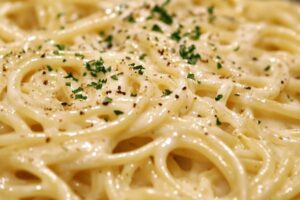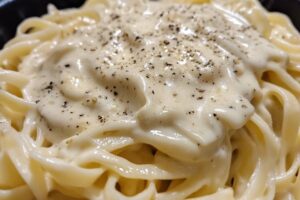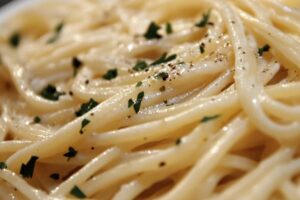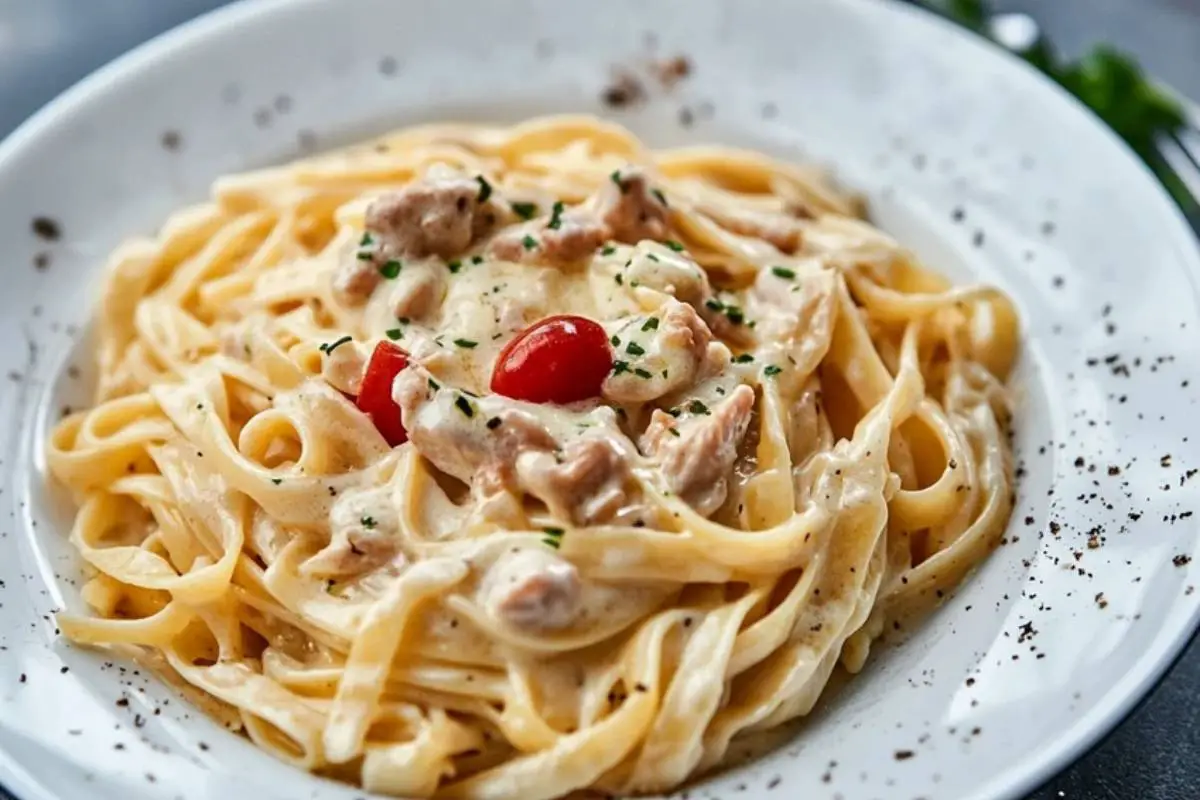Alfredo sauce is a creamy, rich topping that makes pasta dishes decadent and satisfying. But, making the perfect Alfredo pasta is more than just adding sauce to noodles. We’ll look into Alfredo sauce’s origins, ingredients, and how to prepare pasta for it. Plus, we’ll share tips to enhance your Alfredo pasta creations.
Key Takeaways
- Alfredo sauce has its roots in Italian cuisine, made with butter, Parmesan cheese, and cream.
- Properly preparing the pasta by tossing it with the sauce is crucial for achieving the right texture and flavor.
- You can add proteins and vegetables to create a more robust and nutritious Alfredo pasta dish.
- Homemade Alfredo sauce can be more flavorful than store-bought, but both options have their merits.
- Alfredo pasta pairs well with a variety of side dishes, such as garlic bread and salad.
Understanding Alfredo Sauce
Alfredo sauce is a creamy Italian pasta sauce loved worldwide. It comes from Rome, Italy. It’s made with butter, parmesan cheese, and cream. Chef Alfredo di Lelio created it in the early 1900s for his pregnant wife.
Origins and Ingredients
The basic Alfredo sauce recipe involves melting butter and whisking in parmesan cheese. This makes a smooth sauce. Some recipes add heavy cream or half-and-half for extra richness. The best Alfredo uses fresh, high-quality ingredients.
Variations and Flavors
There are many Alfredo sauce variations. Garlic Alfredo adds a savory flavor. Cajun Alfredo brings a bold, zesty taste. Sun-dried tomato Alfredo is tangy, while pesto Alfredo combines richness with basil pesto.
| Alfredo Sauce Variation | Key Ingredients | Flavor Profile |
|---|---|---|
| Garlic Alfredo | Butter, parmesan, cream, garlic | Savory, aromatic |
| Cajun Alfredo | Butter, parmesan, cream, cajun seasoning | Bold, spicy |
| Sun-dried Tomato Alfredo | Butter, parmesan, cream, sun-dried tomatoes | Tangy, bright |
| Pesto Alfredo | Butter, parmesan, cream, basil pesto | Creamy, herbal |
Preparing Pasta for Alfredo Sauce
Creating the perfect Alfredo dish starts with the pasta. Cooking it just right is key for a great taste and texture. Let’s look at how to prepare pasta for alfredo sauce and get it cooked to perfection.
The Art of Achieving Al Dente Pasta
The secret to cooking pasta for alfredo is al dente. This means the pasta is still a bit firm. It’s perfect for Alfredo sauce, adding a nice chewiness.
- Bring a large pot of salted water to a rolling boil.
- Add the pasta and cook as the package says, usually 8-12 minutes.
- Check the pasta often to see if it’s al dente. It should feel slightly firm.
- Drain the al dente pasta for alfredo and toss it with the Alfredo sauce.
By cooking the pasta just right, the Alfredo sauce sticks to it. This makes for a great meal.
| Pasta Type | Cooking Time for Al Dente |
|---|---|
| Fettuccine | 8-10 minutes |
| Penne | 10-12 minutes |
| Linguine | 9-11 minutes |
Remember, cooking time can change with different pasta brands. Always taste the pasta to get it just right.
Can you just add Alfredo sauce to pasta?

Quick and Easy Method
It might seem easy to just pour Alfredo sauce over pasta. But there’s a better way to get a creamy, well-blended dish. By following a few simple steps, you can make a tasty quick alfredo pasta full of flavor.
To add alfredo sauce to pasta right, toss them together when the pasta is still hot. This way, the sauce coats the noodles evenly, making for a smooth and easy alfredo pasta experience. Here’s how to do it:
- Cook your pasta as the package says, saving a cup of starchy water before draining.
- In a big, warm bowl, mix the cooked pasta and Alfredo sauce. Gently toss to coat the noodles well.
- If the sauce is too thick, add a few tablespoons of pasta water slowly. Stir constantly until it’s right.
- Then, serve the quick alfredo pasta right away. Add some fresh parsley or Parmesan cheese if you like.
This easy alfredo pasta method makes sure the sauce is mixed in well. It creates a creamy and tasty dish that will satisfy your hunger.
Enhancing Alfredo Pasta Dishes
Classic Alfredo pasta is already tasty, but you can make it even better. Adding proteins and fresh vegetables can boost the flavor and health benefits. This way, your Alfredo pasta becomes more satisfying.
Adding Proteins
Grilled or sautéed chicken pairs well with Alfredo sauce. It adds a lean protein that complements the creamy sauce. Shrimp also works great, bringing a light seafood flavor that contrasts well with the Alfredo.
For a vegetarian choice, try sautéed tofu or roasted chickpeas. They increase the protein in your dish.
Incorporating Vegetables
- Broccoli: Steamed or sautéed broccoli adds a crunchy texture and nutrients to Alfredo pasta.
- Spinach: Fresh baby spinach leaves blend well with the warm Alfredo sauce, adding greens.
- Sun-Dried Tomatoes: Their intense flavor contrasts nicely with the creamy Alfredo sauce.
- Asparagus: Roasted or grilled asparagus spears add a fresh, vibrant touch to the dish.
By mixing different proteins and vegetables, you can turn your Alfredo pasta into a balanced meal. It will please your taste buds and meet your nutritional needs.
Homemade vs Store-Bought Alfredo Sauce
Choosing between homemade and store-bought Alfredo sauce is a common debate. Both have their advantages, depending on your taste and cooking habits.
Homemade alfredo sauce is known for its fresh, creamy taste. It’s made with real butter, heavy cream, and Parmesan cheese. This way, you can adjust the flavors to your liking.
Store-bought alfredo sauce is quicker and easier. It comes in many flavors and can be added to your meals fast. While it may not taste as rich as homemade, it’s still a good choice for a quick Alfredo fix.
| Homemade Alfredo Sauce | Store-Bought Alfredo Sauce |
|---|---|
| Fresh, creamy, and rich flavor | Convenient and readily available |
| Ability to control ingredients and adjust flavors | Variety of flavors to choose from |
| More time-consuming to prepare | Faster and easier to incorporate into meals |
| Typically made with high-quality ingredients | May not match the depth of flavor in homemade |
Whether you choose homemade alfredo sauce or store-bought alfredo sauce depends on your taste, time, and the dish you’re making. Both can make your meal delicious, so try both and see what you like best.
Serving Suggestions for Alfredo Pasta

Alfredo pasta is a delightful and indulgent dish that can be enjoyed as the main course. Pairing it with complementary side dishes can elevate the overall dining experience. Consider these tasty accompaniments that will balance the richness of the creamy sauce.
Pairing with Sides
A fresh, crisp salad is a classic pairing for alfredo pasta. The cool, refreshing greens contrast nicely with the warm, creamy alfredo. Try a simple mixed green salad with a light vinaigrette or a Caesar salad to complement the flavors.
Roasted vegetables are another excellent side dish option. Asparagus, broccoli, or roasted cauliflower add a burst of color and texture. They balance the richness of the alfredo pasta.
| Side Dish | Pairing Rationale |
|---|---|
| Mixed Green Salad | The fresh, crisp greens provide a light counterpoint to the creamy alfredo sauce. |
| Roasted Vegetables | The caramelized, slightly crunchy vegetables add texture and balance the richness of the pasta. |
| Garlic Bread | The toasted, garlicky bread can soak up the excess sauce, making for a satisfying bite. |
| Steamed Broccoli | The bright green florets add a pop of color and nutritional value to the meal. |
Garlic bread is another classic choice. The toasted, garlicky bread soaks up the excess sauce, creating a satisfying bite. For a nutritional boost, consider steaming some broccoli to serve alongside the alfredo pasta.
By carefully selecting complementary side dishes, you can create a well-balanced and delightful dining experience when serving alfredo pasta.
Alfredo Sauce Alternatives
Looking for something different from traditional Alfredo sauce? There are many options that fit various diets and tastes. Whether you’re avoiding dairy, want a vegan choice, or just want to try something new, these alternatives are tasty and flexible.
Dairy-Free Alfredo Sauce
For those who can’t have dairy or follow a vegan diet, there are creamy, indulgent options. Cashew-based sauces blend soaked cashews with non-dairy milk and spices for a rich feel. You can also use almond or coconut milk as a base, adding garlic, nutritional yeast, and lemon for a tangy twist.
Cauliflower-Based Sauces
Cauliflower can be turned into a creamy, dairy-free Alfredo sauce. Blend cooked cauliflower with non-dairy milk, garlic, and spices for a sauce that’s thick and creamy. It’s a healthier choice and adds nutrients from the cauliflower.
| Alfredo Sauce Alternative | Key Ingredients | Dietary Considerations |
|---|---|---|
| Cashew-Based Alfredo | Soaked cashews, non-dairy milk, garlic, seasonings | Dairy-free, vegan |
| Almond Milk Alfredo | Almond milk, garlic, nutritional yeast, lemon juice | Dairy-free, vegan |
| Cauliflower Alfredo | Cooked cauliflower, non-dairy milk, garlic, seasonings | Dairy-free, vegan, low-carb |
Exploring these alfredo sauce alternatives lets you enjoy creamy Alfredo pasta dishes while meeting your dietary needs or preferences.
Storing and Reheating Leftovers
Enjoying Alfredo pasta is a treat, but what about leftovers? The right storage techniques and reheating methods keep your Alfredo pasta creamy and flavorful, even after it’s chilled.
Proper Storage Techniques
To store Alfredo pasta right, just follow these easy steps:
- Let the pasta cool down completely before putting it in an airtight container.
- Make sure the container is tightly closed to keep air out and prevent drying.
- Put the Alfredo pasta in the fridge, where it stays good for 3-4 days.
- Don’t let the pasta sit at room temperature for more than 2 hours, as bacteria can grow.
Storing Alfredo pasta properly is key to keeping its tasty flavor and smooth texture.
Reheating Alfredo Pasta
Ready to enjoy your Alfredo pasta leftovers? Here’s how to reheat Alfredo pasta the right way:
- Put the pasta in a microwave-safe dish and add a tablespoon of milk or cream for each serving.
- Cover the dish and microwave in 30-second bursts, stirring between each, until it’s hot.
- You can also reheat it on the stovetop over low heat, stirring often to avoid sticking or drying.
- Use a bit more milk or cream if needed to keep it creamy.
By using these simple storage and reheating techniques, your Alfredo pasta leftovers will taste just as good as when they were first made.
“The secret to delicious Alfredo pasta leftovers is in the storage and reheating methods.”
Nutritional Considerations
Enjoying Alfredo pasta can be a treat, but we should know its nutritional facts. It’s key to understand the calorie, fat, and carb counts. This helps us make better choices.
Alfredo pasta has a lot of calories, about 400-600 per serving. Most of these calories come from the heavy cream and butter. These ingredients are high in saturated fat.
| Nutrient | Amount per Serving |
|---|---|
| Calories | 400-600 |
| Total Fat | 20-40g |
| Saturated Fat | 12-20g |
| Carbohydrates | 40-50g |
| Protein | 20-30g |
To make Alfredo pasta healthier, try these tips:
- Use low-fat or reduced-fat dairy in the sauce. This reduces saturated fat and calories.
- Add more veggies like broccoli, spinach, or cherry tomatoes. They add fiber, vitamins, and minerals.
- Pair it with lean protein like grilled chicken or shrimp. This balances the meal and adds lean protein.
With these tweaks, you can still enjoy Alfredo pasta’s creamy taste. Just remember, a little goes a long way.
Creative Twists on Classic Alfredo Pasta

To keep your Alfredo pasta exciting, try new ingredients and techniques. Use different cheeses like Gruyère or Parmesan for a richer taste. Adding spices like nutmeg or white pepper can make the sauce even creamier.
For a special Alfredo pasta, add seafood. Shrimp or scallops make it luxurious. Roasted veggies like asparagus or red peppers add freshness and balance.
These creative twists keep your taste buds interested. They show how versatile Alfredo pasta can be. Whether you want a comforting dish or something new, there are endless options for creative alfredo pasta recipes, unique alfredo pasta dishes, and alfredo pasta variations.
FAQ
Can you just add Alfredo sauce to pasta?
Yes, you can add Alfredo sauce to cooked pasta. But for the best taste, follow a few steps. This ensures the sauce mixes well and the dish stays creamy.
What is the origin and typical ingredients of Alfredo sauce?
Alfredo sauce comes from Rome, Italy. It’s made with butter, parmesan cheese, and heavy cream. Alfredo di Lelio created it in the early 1900s.
What are some common variations and flavors of Alfredo sauce?
Classic Alfredo sauce has just a few ingredients. But, you can also try garlic Alfredo, Cajun Alfredo, or sun-dried tomato Alfredo for different tastes.
How do I properly prepare pasta for Alfredo sauce?
Cooking pasta al dente is key for a great Alfredo dish. Follow the package instructions. Cooking it a bit less helps it soften with the hot sauce.
What is the quick and easy method for adding Alfredo sauce to pasta?
For easy Alfredo pasta, toss cooked pasta with the sauce over low heat. Stir until the sauce coats the noodles evenly.
How can I enhance my Alfredo pasta dishes?
Add proteins like grilled chicken or shrimp for extra flavor. Fresh vegetables also help balance the sauce’s richness.
What are the pros and cons of using homemade versus store-bought Alfredo sauce?
Homemade sauce is richer and customizable. Store-bought is quicker and easier. Choose based on your time, skill, and taste.
What sides pair well with Alfredo pasta?
Pair Alfredo pasta with garlic bread, a fresh salad, or roasted veggies. These sides balance the creaminess of the pasta.
Are there any Alfredo sauce alternatives for those with dietary restrictions?
Yes, there are dairy-free or vegan Alfredo sauce options. They use ingredients like cashews or plant-based milks.
How should I store and reheat leftover Alfredo pasta?
Store leftover pasta in an airtight container in the fridge for 3-4 days. Reheat on low heat, stirring often, to avoid a thick sauce.
What are the nutritional considerations for Alfredo pasta?
Alfredo pasta is rich and high in calories and fat. But, you can make it healthier by using low-fat dairy or adding veggies.
What are some creative twists on classic Alfredo pasta?
Try different cheeses, spices, or seafood to spice up Alfredo pasta. Experimenting leads to new, tasty creations.

